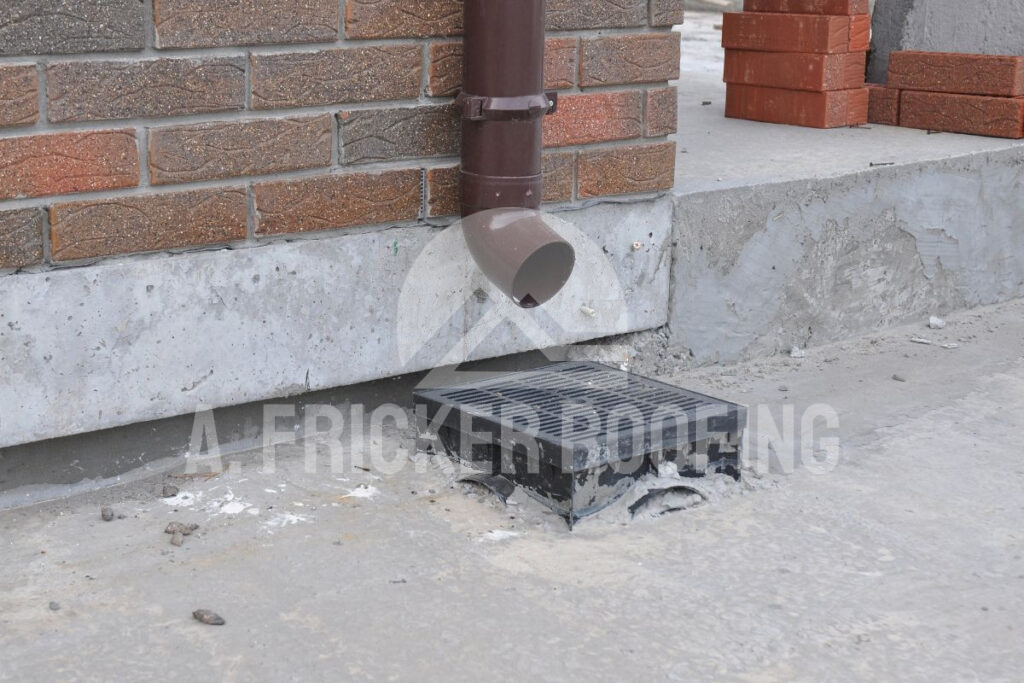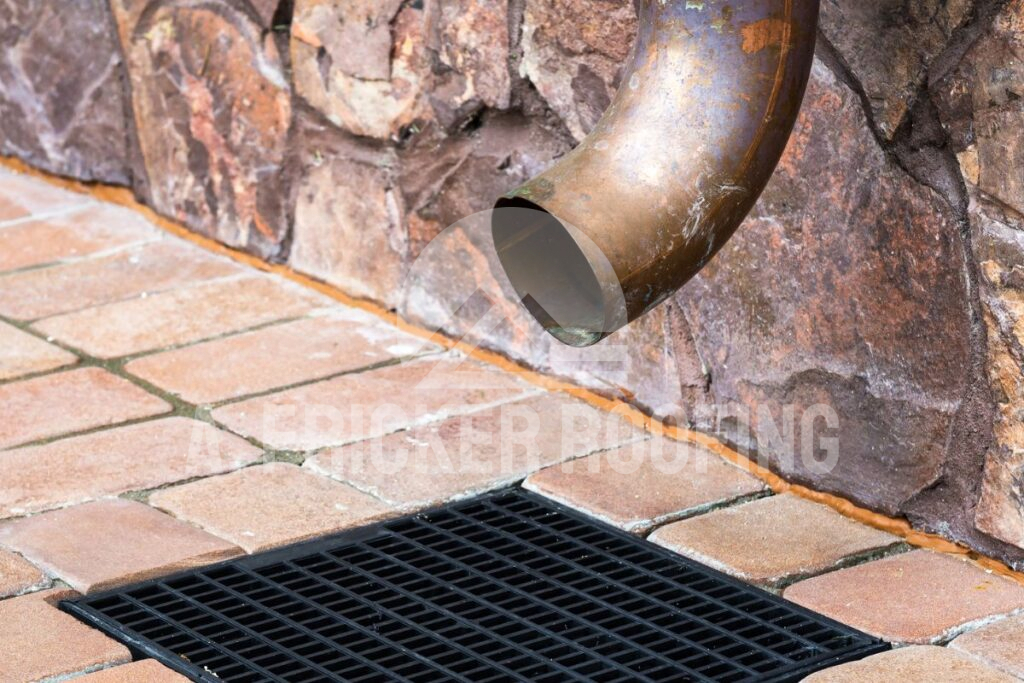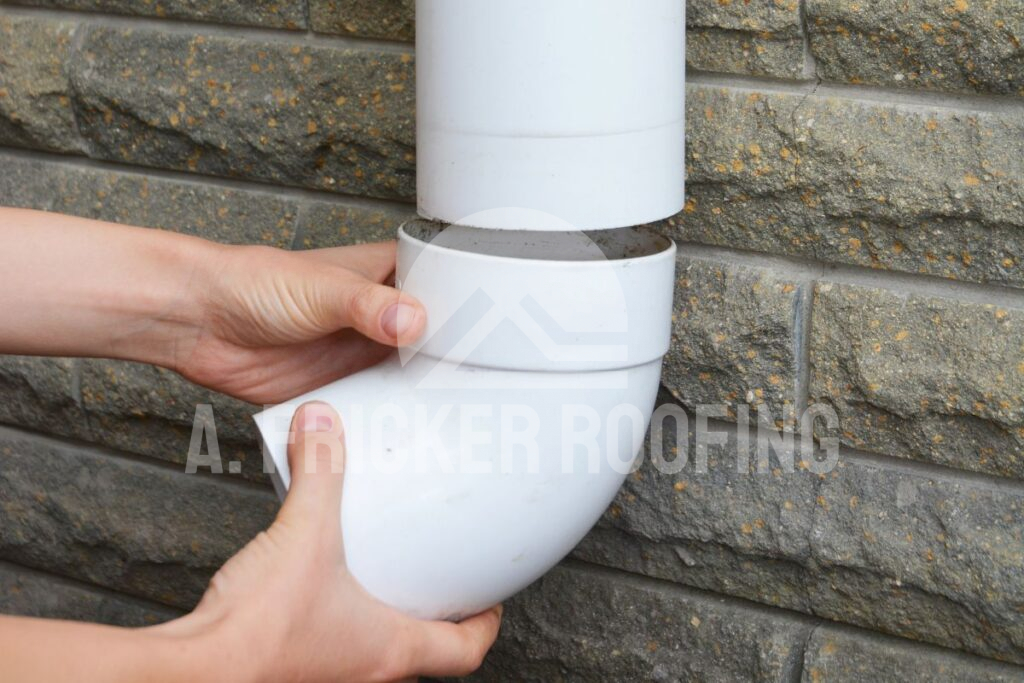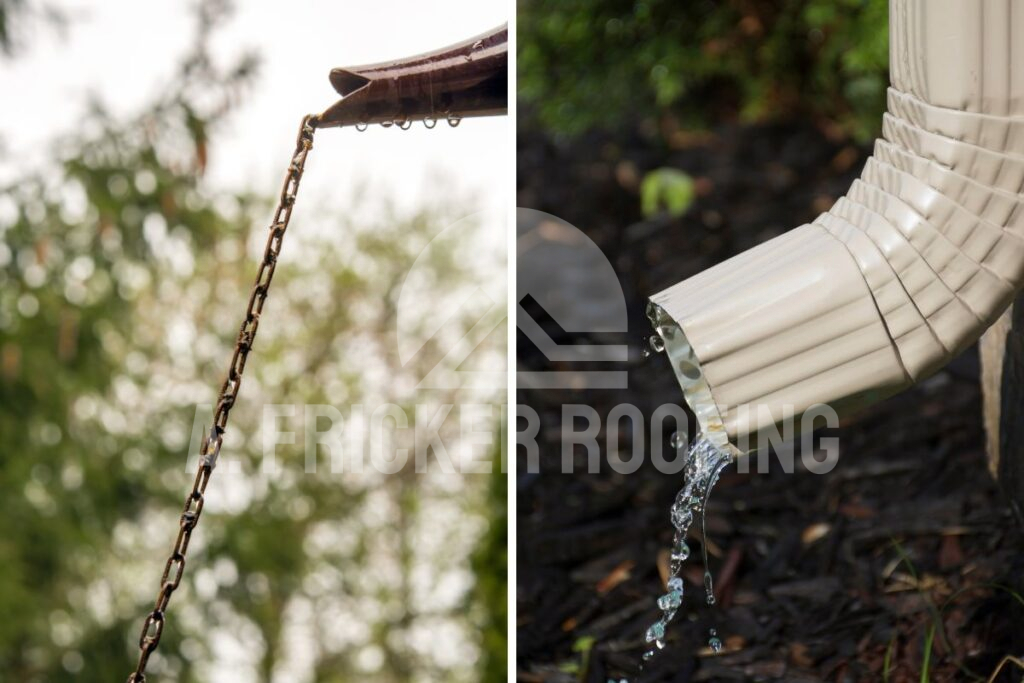A downspout is one component of your home’s drainage system that works together with the gutters to protect your home from water damage. Downspouts are the enclosed pathways that channel the water from the gutters to the ground and away from the house. Without them, rain and debris would pool around the foundation, potentially causing major damage.
In this blog post, we will discuss everything you need to know about downspouts, including their function, different types, and how to determine how many you need for your property.
What Are Downspouts?

Downspouts are vertical pipes attached to the edges of your roof that are responsible for channeling rainwater from the gutters to the ground. They play a crucial role in preventing water accumulation on the roof, which can lead to various issues, including leaks, mold growth, and structural damage.
Effective downspouts are essential for maintaining the integrity of your home. They ensure that rainwater is directed away from the foundation, preventing erosion and potential water damage to the structure. Properly sized and spaced downspouts contribute to the overall longevity and functionality of your roof.
The Importance of Downspouts In Water Drainage & Home Protection
Without downspouts, your home would likely sustain water damage. Here are just a few reasons why they are crucial for every property:
1. Preserves the Home’s Foundation
One of the primary functions of downspouts is to redirect rainwater away from the foundation of your home. Without proper drainage, water accumulation around the foundation can lead to soil erosion and compromise the structural stability of the entire house. Downspouts act as the first line of defense against potential foundation issues, providing an effective channel for rainwater to be safely directed away from critical areas.
2. Prevents Basement Flooding
Basement flooding can be a homeowner’s worst nightmare, and downspouts play a crucial role in preventing this common issue. By efficiently guiding rainwater away from the foundation, downspouts reduce the risk of water seeping into the basement. This proactive measure not only protects your possessions but also helps maintain a dry and usable space within your home.
3. Protects Siding and Exterior
In addition to foundation and basement protection, downspouts contribute to preserving the exterior aesthetics of your home. Without proper drainage, rainwater can streak down the sides of your house, leaving stains and potentially damaging the siding. Well placed and adequately sized downspouts ensure that water is efficiently carried away, minimizing the risk of exterior water damage.
Also Read: 3 Easy Ways To Restore Faded Vinyl Siding
4. Prevents Erosion
Beyond the immediate structure of your home, downspouts also play a role in safeguarding your landscaping. Without proper drainage, rainwater running off the gutters can erode soil, damage plants, and create puddles. However, well-maintained downspouts contribute to the preservation of your outdoor spaces.
Types of Downspouts
There are many types of downspouts to consider for your home, including:
1. Copper Downspouts

Copper downspouts are a unique and elegant option for homeowners looking to enhance the visual appeal of their exteriors. Over time, copper develops a distinct patina, adding character to your home. In addition to their aesthetic charm, copper downspouts are durable and resistant to corrosion.
2. Aluminum Downspouts
Aluminum downspouts are lightweight, rust-resistant, and easy to install. They come in various styles, including rectangular and round, offering versatility to homeowners. Aluminum downspouts are a cost-effective choice that provides durability and low maintenance.
3. Vinyl Downspouts

Vinyl downspouts are known for their affordability and ease of maintenance. They are resistant to rust and corrosion and come in various colors to match your home’s exterior. Vinyl downspouts are a popular choice for homeowners seeking a budget-friendly and practical drainage solution.
Different Downspout Styles
Along with various materials, there are also different styles of downspouts you can choose from.
1. Rectangular Downspouts

Rectangular downspouts are a common and classic choice, known for their simplicity and functionality. They come in standard sizes, such as 2×3 inches or 3×4 inches, and are compatible with most gutter systems. Rectangular downspouts are versatile, fitting well with a variety of architectural styles.
2. Round Downspouts

Round downspouts provide a sleek and modern aesthetic to your home’s exterior. They are available in different diameters, allowing for customization based on your specific drainage needs. Round downspouts work well with contemporary and architectural designs, adding a touch of elegance to the overall appearance.
How Many Downspouts Do You Need For Your Home?
When it comes to calculating the number of downspouts your home may need, the following factors play a significant role.
1. Roof Size and Pitch
The size and pitch of your roof are primary factors influencing the number of downspouts needed. A larger roof collects more rainwater, requiring additional downspouts to handle the increased volume. Additionally, roofs with steeper pitches may necessitate more downspouts to accommodate faster water runoff.
2. Local Rainfall Intensity
The local climate and rainfall intensity play a significant role in determining downspout quantity. Homes in areas with heavy rainfall require a more robust drainage system to manage the increased water flow effectively.
3. Downspout Size and Capacity
The size of the gutters and the capacity of the chosen downspouts influence the overall drainage efficiency. Larger downspouts can handle more water, but the number needed depends on the roof size and expected rainfall. Professionals use specific calculations to match downspout capacity with the potential water flow.
4. Gutter Design
The design of your gutter system is closely related to the number of downspouts your home needs. Because properly designed gutters distribute water evenly, influencing the spacing and number of downspouts needed. One of the prominent gutter designs is K-style gutters, which have dominated the market for years.
Where Should You Install Downspouts On Your Home?
The following are the common places that can be used to install downspouts. However, if your roof has some additional features, then you can choose to place them accordingly.
1. Roof Corners
One of the primary locations for downspout installation is at the corners of your roof. Since water tends to accumulate at these points, the downspouts positioned here facilitate the efficient drainage of rainwater, preventing overflow and potential damage to the structure.
2. Valleys and Intersections
Roof valleys, where two slopes meet, and intersections between different sections of your roof are areas prone to increased water flow. Installing downspouts in these locations helps manage water runoff effectively and prevents concentrated flow that could lead to erosion or foundation issues.
3. Customize Depending on the Roof’s Features
If your home has unique features such as dormers or extensions, customize downspout placement to accommodate these structures. Adapting the placement to the specific design of your home ensures that water is efficiently directed away from all areas, including those with distinct architectural elements.
Rain Chain vs. Downspouts: Which To Choose

While the purpose of downspouts and rain chains is the same, they differ in many ways.
1. Practicality vs. Aesthetics
Downspouts: If practical water drainage is the primary concern and customization is less of a priority, downspouts are a straightforward and effective choice.
Rain Chains: For homeowners prioritizing aesthetics and seeking a visually appealing alternative to downspouts, rain chains offer an artistic and decorative solution.
2. Budget Considerations:
Downspouts: Generally more budget friendly, downspouts are a cost effective option for homeowners looking for a practical and efficient water drainage solution.
Rain Chains: While some rain chains are affordable, intricate designs and high end materials may come with a higher cost.
Tips for a Successful Downspout Installation
If you are thinking of installing downspouts on your home, follow these tips for a successful project.
1. Use Quality Materials
Invest in durable downspouts made of materials like aluminum, copper, or vinyl for longevity and resistance to corrosion. Ensure that all additional components, such as brackets and screws, are of high quality and compatible with your chosen downspout materials.
2. Secure Downspouts Properly
Use brackets to secure the downspouts to the exterior wall. Ensure that the brackets are straight and properly aligned by using a level during installation.
3. Check Local Building Codes
Before starting the installation, check local building codes and regulations to ensure compliance with any specific requirements regarding downspout placement and materials.
4. Test the System
Conduct a water test after installation to check for proper water flow through the gutters and downspouts. Identify and address any issues, such as leaks or obstructions, before they become larger problems.
Final Thoughts
The role of downspouts in roof water drainage cannot be overstated. Choosing the right size and spacing for your downspouts is a proactive measure to safeguard your home from potential water damage. Whether you’re considering a new installation or evaluating your existing system, consulting with roofing professionals can provide valuable insights into optimizing your downspout setup.
Contact Professional Roofers In Tulsa, OK, For Your Gutter And Downspout Installation
If you are thinking of installing new gutters or upgrading the existing gutters and downspouts on your home or office in Tulsa, OK, contact our team of talented and experienced professionals. A. Fricker Roofing and Waterproofing in Tulsa, OK, is a leading roofing and home exterior company specializing in roof and gutter installation. Contact us today at (918) 402-7167 and consult a professional contractor.

